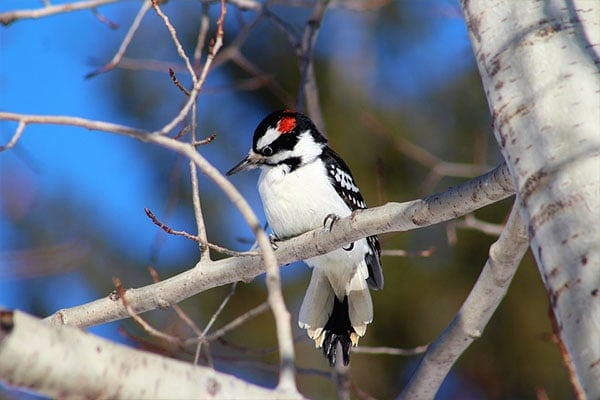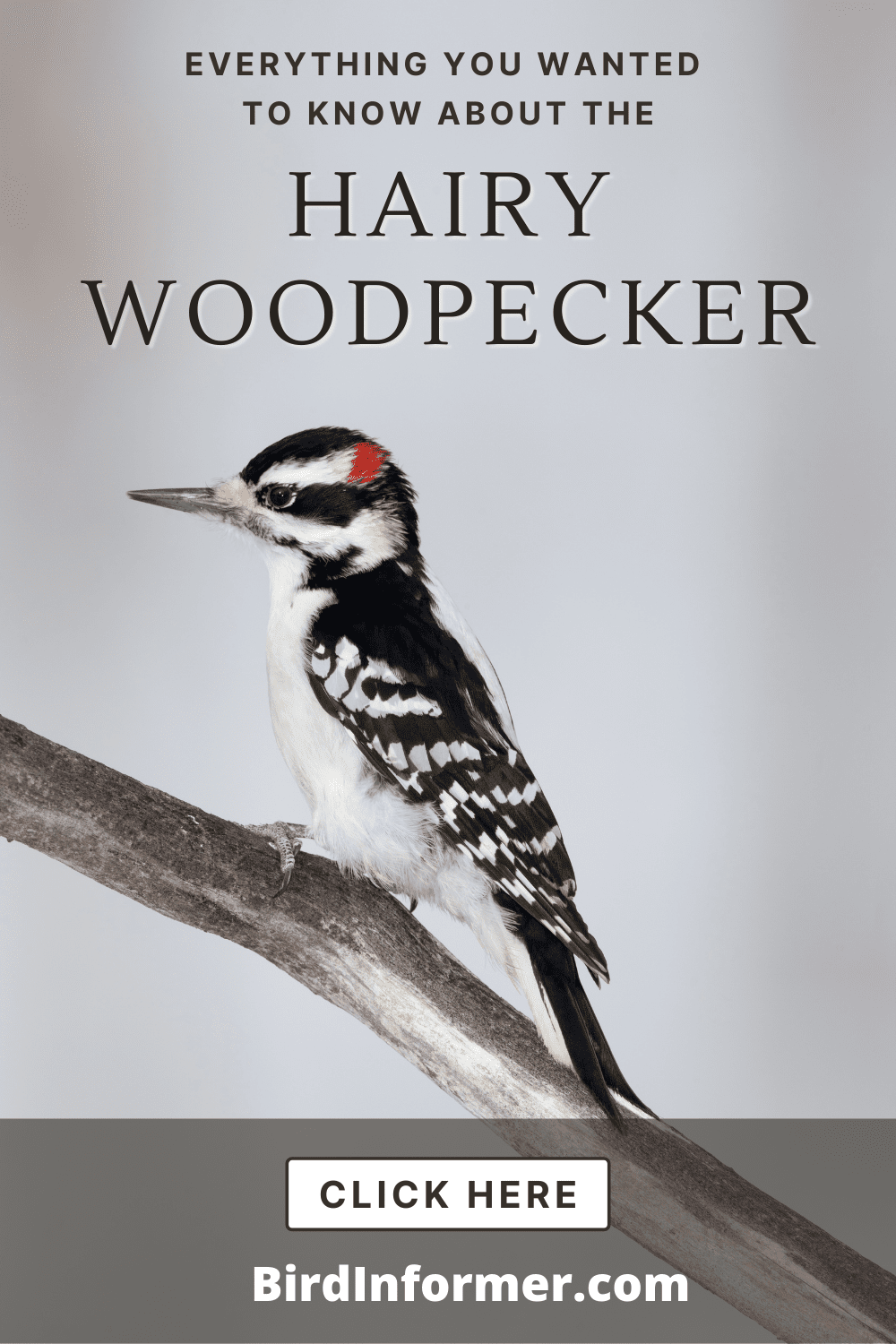Contents
- Hairy woodpecker facts
- Hairy woodpecker: how-to identify
- Hairy woodpecker bird vocalization
- Where You’ll See Hairy Woodpeckers
- Hairy woodpecker diet
- Hairy woodpecker nesting
- Hairy woodpecker behavior
- How-to attract hairy woodpeckers
- Hairy woodpecker threats
- Hairy woodpecker fun & interesting facts
- Hairy woodpecker-related species in this family
The Hairy Woodpecker is characterized by its black and white color pattern and long bill. They look very similar to Downies but are larger. These birds are usually seen on high elevations and would mainly search for food on trees. They also contribute a lot to pest control, especially in populations of moths and beetles on trees.
In this article, we are going to cover a wide variety of topics related to the Hairy Woodpecker, such as:
- How to identify them
- How, when, and where they migrate
- Their diet
- How and where they nest
- And much more…
So, without any more delay…
Let’s jump right into it and learn more about the Hairy Woodpecker.
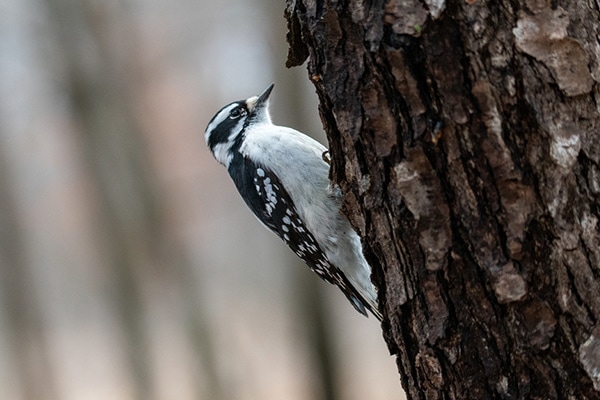
Hairy woodpecker facts
- Common Name: Hairy Woodpecker
- Scientific Name: Dryobates villosus
- Scientific Family: Picidae
- Life Span: 15 years
- Size: 7.1 to 10.2 inches
- Wingspan: 13.0 to 16.1 inches
- Weight: 1.4 to 3.4 oz
- Conservation status: Least Concern (LC)
Hairy woodpecker: how-to identify
Hairy Woodpeckers are medium-sized birds characterized by a relatively long bill, square head, and long tail. The color pattern is a combination of black and white.
The birds feature a predominantly black head with white lines on regions above and under the eyes. Their nape is black, back is white, wings are black with white spots, and underparts are white. The tail is black with white outer tail feathers.
These birds look pretty similar to the Downy Woodpecker, but they are larger and longer bills. The outer tail feather is plain white overall, compared to the Downies that have spots.
Differences Between Male & Female
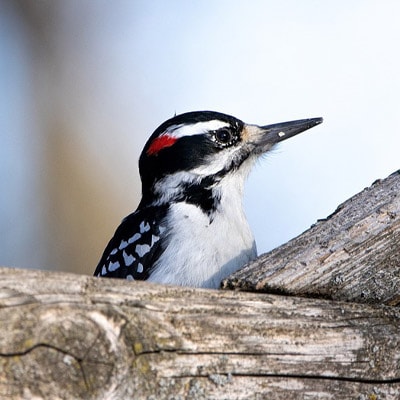
Male and female Hairy Woodpeckers look very similar, but it’s still easy to tell them apart. This is because male Hairy Woodpeckers feature a red patch on their head. Quite similar to the Downies, but it is found that the red patch on Hairy Woodpeckers is usually split into two.
Differences In Summer Plumage vs Winter Plumage
Hairy Woodpeckers look the same all-year-round, regardless if it’s the summer or winter season.
Hairy woodpecker bird vocalization
Where You’ll See Hairy Woodpeckers
Hairy Woodpeckers are common across North America. Their population ranges from Alaska to Newfoundland, going down to the north of Mexico. There are also times when the birds are found in Florida, but it’s very rare.
These birds love staying in forested areas where many coniferous or deciduous trees are located. They love staying in dense areas, but they can also be found in open areas like the suburbs, parks, or even cemeteries. They are also frequent in edges of forests, around ponds, orchards, and recently burned forests.
Hairy woodpecker bird migration
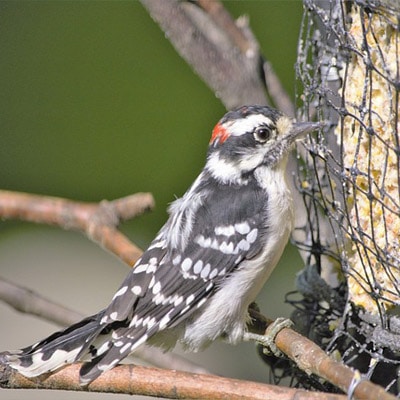
Hairy Woodpeckers are resident birds, meaning they mainly stay in the same place all-year-round. However, it has been found that some populations in the north would fly short distances down south for winter. Sometimes they would be found in Guatemala, Costa Rica, and Panama.
There are also cases where Hairy Woodpeckers breeding in higher areas would move down near the coast or anywhere low during the winter season.
Hairy woodpecker diet
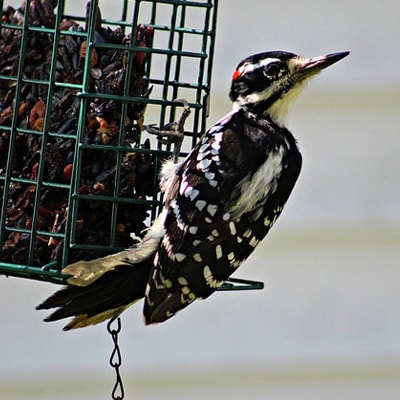
Hairy Woodpeckers eat various foods, but 75% of their diet is made up of insects. They most especially love the larvae of bark beetles or other beetles, ants, and moth pupae. If these are not available, they will eat bees, wasps, spiders, and caterpillars.
Because Hairy Woodpeckers love eating bark beetle larvae, they help control the populations of bark beetles. These birds would often come in large groups to eat these insects, and the same thing happens with wood-boring beetle larvae and moth pupae (in orchards).
When insects are low in numbers, the birds will eat nuts, seeds, berries, and other fruits, too. They will also visit bird feeders for suet and sunflower seeds.
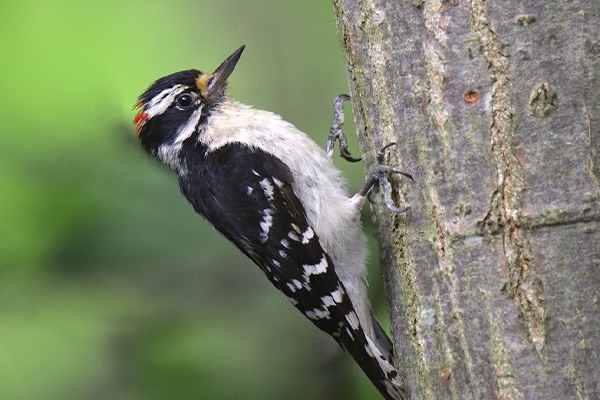
Hairy woodpecker nesting
- Clutch Size: 3-6 eggs
- # of Broods: 1 brood
- Incubation Period: 11-12 days
- Nestling Period: 28-30 days
- Egg Description: All white
Male and female Hairy Woodpeckers usually stay in different territories early in winter and only pair up mid-winter. Females usually stay in their territories, and this typically becomes the nesting site once a pair forms.
These birds will excavate nests on dead stubs of living or dead trees, usually 4-60 meters off the ground. Males are the ones who do most of the work, and excavation would usually take two weeks or less.
Unlike other birds who lay in some twigs and leaves to form a cup-shaped nest, the Hairy-Woodpecker’s nest is bare. There are only wood chips laid at the bottom where the eggs will rest.
Hairy woodpecker behavior
Hairy Woodpeckers, like many woodpeckers, are often seen climbing on tree trunks or large tree branches, leaning back against their stiff tail. These birds mainly search for food on large trees or branches, unlike Downies, who would also feed on weed stalks.
These are timid birds and are usually found in pairs rather than in groups. They would also react fast, even to minimal amounts of disturbance.
When disturbed, Hairy Woodpeckers usually make a noise, or they will begin tapping or pecking on a tree. If they feel threatened, they sometimes let out a call and flutter their wings to show aggression.
How-to attract hairy woodpeckers
Just like with many birds, you’ll be able to attract Hairy Woodpeckers if you provide them with their needs.
Since these birds mainly eat insects, you have the option to make your yard insect-friendly. But, you can also hang upright feeders filled with suet and sunflower seeds. If there are dead trees around you, and it’s safe for you even if you don’t cut them, make them available for the birds as a food source or nest site.
Provide some bird baths around the area so that birds will have something to drink or bathe into. A ground birdbath would be most ideal, but make sure to place it in an area with less to no disturbance.
Hairy woodpecker threats
Hairy Woodpeckers are widespread across North America, with their numbers continuously increasing. They belong to the “least concern” group in terms of conservation. However, as forest areas grow smaller, competition for nest holes increases, which eventually can threaten these birds’ population.
Hairy woodpecker fun & interesting facts
- Hair woodpeckers can tap on wood so fast at a speed of 100 taps in one minute.
- The only difference they have with downy woodpeckers is their size and bill length.
- There are 17 subspecies of Hairy Woodpeckers found in different areas.
- These birds help control populations of bark beetles, wood-boring beetles, and moths.
- The oldest recorded Hairy Woodpecker lived for 15 years and 11 months.
- Williamson’s Sapsucker
- Yellow-bellied Sapsucker
- Red-naped Sapsucker
- Red-breasted Sapsucker
- Lewis’s Woodpecker
- Red-headed Woodpecker
- Acorn Woodpecker
- Gila Woodpecker
- Golden-fronted Woodpecker
- Red-bellied Woodpecker
- American Three-toed Woodpecker
- Black-backed Woodpecker
- Downy Woodpecker
- Nuttall’s Woodpecker
- Ladder-backed Woodpecker
- Red-cockaded Woodpecker
- White-headed Woodpecker
- Arizona Woodpecker
- Ivory-billed Woodpecker
- Pileated Woodpecker
- Northern Flicker
- Gilded Flicker

